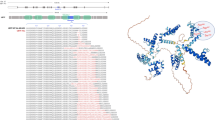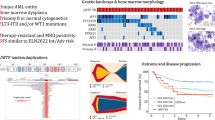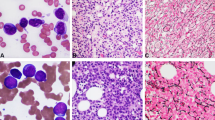Abstract
Partial tandem duplications of the MLL gene have been associated with trisomy 11 in acute myeloid leukemia (AML) and recently, have also been reported for karyotypically normal AML. In order to test the incidence and prognostic importance of this molecular marker, we have analyzed eight cases of AML with trisomy 11 and 387 unselected consecutive cases with AML for partial duplications of the MLL gene. Patients with normal karyotypes and those with various chromosome aberrations were included. De novo as well as secondary leukemias including all FAB subtypes were analyzed. Performing a one-step RT-PCR with 35 cycles using an exon 9 forward primer and an exon 3 reverse primer partial tandem duplications of the MLL gene were demonstrated in 3/8 (37.5%) patients with trisomy 11. In addition, 13/387 (3.4%) of unselected cases revealed a tandem duplication. Ten of these 13 cases were cytogenetically normal, the other three cases had ⩽2 additional chromosomal alterations. Sequencing of the RT-PCR products of all 16 positive cases revealed fusions of MLL exon 9/exon 3 (e9/e3) (six cases), e10/e3 (three cases), e11/e3 (four cases) or combinations of differentially spliced e10/e3 and e11/e3 (three cases) transcripts. The duplications were confirmed by genomic long range PCR and Southern blot hybridization. Twelve cases with the MLL duplication were de novo myeloid leukemia, one was a secondary AML after MDS, three were therapy-related AML (t-AML). Of the 16 MLL-duplication positive cases, seven were classified as FAB M2, two as M1, five as M4, one as M0, one as M5b. The mean age was 62.3 years for patients with MLL duplication vs 50.3 years for the control group. Of 15 adult patients, 12 received treatment. Of these, three were non-responders, five had early relapse (⩽6 months), four relapsed between 7 and 12 months. Median survival and relapse-free interval of the MLL duplication positive group was significantly worse than those of an age-matched karyotypically normal control group. In conclusion, MLL tandem duplications (1) are less common than previously reported; (2) are preferentially observed in AML with normal karyotypes, but can also be found in the presence of chromosome alterations; (3) are not strongly associated with an FAB subtype; (4) were not observed with the prognostically favorable t(8;21), inv(16), and t(15;17), other recurrent translocations, or in complex karyotypes; and (5) identifies a subgroup of patients with an unfavorable prognosis.
This is a preview of subscription content, access via your institution
Access options
Subscribe to this journal
Receive 12 print issues and online access
$259.00 per year
only $21.58 per issue
Buy this article
- Purchase on Springer Link
- Instant access to full article PDF
Prices may be subject to local taxes which are calculated during checkout








Similar content being viewed by others
References
Bernard OA, Berger R . Molecular basis of 11q23 rearrangements in hematopoietic malignant proliferations Genes Chromos Cancer 1995 13: 75–85
Nilson I, Löchner K, Siegler G, Greil J, Beck J, Fey G, Marschalek R . Exon/intron structure of the human ALL-1 (MLL) gene involved in translocations to chromosomal region 11q23 and acute leukemias Br J Hematol 1996 93: 966–972
Drexler HG, Thiel E, Ludwig WD . Review of the incidence and clinical relevance of myeloid antigen-positive acute lymphoblastic leukemia Leukemia 1991 5: 637–645
Cuneo A, Michaux JL, Ferrant A, Van HL, Bosly A, Stul M, Dal CP, Vandenberghe E, Cassiman JJ, Negrini M et al. Correlation of cytogenetic patterns and clinicobiological features in adult acute myeloid leukemia expressing lymphoid markers Blood 1992 79: 720–727
Kalwinsky DK, Raimondi SC, Schell MJ, Mirro JJ, Santana VM, Behm F, Dahl GV, Williams D . Prognostic importance of cytogenetic subgroups in de novo pediatric acute nonlymphocytic leukemia J Clin Oncol 1990 8: 75–83
Martinez-Climent CJ, Lane NJ, Rubin CM, Morgan E, Johnstone HS, Mick R, Murphy SB, Vardiman JW, Larson RA, Le Beau M, Rowley JD . Clinical and prognostic significance of chromosomal abnormalities in childhood acute myeloid leukemia de novo Leukemia 1995 9: 95–101
Fenaux P, Preudhomme C, Lai J, Morel P, Beuscart R, Bauters F . Cytogenetics and their prognostic value in de novo acute myeloid leukaemia: a report on 283 cases Br J Haematol 1989 73: 61–67
Mrozek K, Heinonen K, Lawrence D, Carroll AJ, Koduru PR, Rao KW, Strout MP, Hutchison RE, Moore JO, Mayer RJ, Schiffer CA, Bloomfield CD . Adult patients with de novo acute myeloid leukemia and t(9;11)(p22;q23) have a superior outcome to patients with other translocations involving band 11q23: a Cancer and Leukemia Group B study Blood 1997 90: 4532–4538
Baer MR, Stewart CC, Lawrence D, Arthur DC, Mrozek K, Strout MP, Davey FR, Schiffer CA, Bloomfield CD . Acute myeloid leukemia with 11q23 translocations: myelomonocytic immunophenotype by multiparameter flow cytometry Leukemia 1998 12: 317–325
Caligiuri M, Schichman SA, Strout MP, Mrozek K, Baer MR, Frankel SR, Barcos M, Herzig GP, Croce CM, Bloomfield CD . Molecular rearrangement of the ALL-1 gene in acute myeloid leukemia without cytogenetic evidence of 11q23 chromosomal translocations Cancer Res 1994 54: 370–373
Schichman SA, Caligiuri M, Strout M, Carter S, Gu Y, Canaani E, Bloomfield C . Croce C. ALL-1 tandem duplication in acute myeloid leukemia with a normal karyotype involves homologous recombination between ALU elements Cancer Res 1994 54: 4277–4280
Schichman S, Caligiuri M, Gu Y, Strout M, Canaani E, Bloomfield C, Croce C . ALL-1 partial duplication in acute leukemia PNAS 1994 91: 6236–6239
Takasaki N, Kaneko Y, Maseki N, Sakurai M . Trisomy 11 in chronic myelomonocytic leukemia: report of two cases and review of the literature Cancer Genet Cytogenet 1988 30: 109–117
Weh HJ, Hoffmann R, Suciu S, Kuse R, Hossfeld DK . Is trisomy 11 another nonrandom chromosomal anomaly in acute nonlymphocytic leukemia and myelodysplastic syndromes? Cancer Genet Cytogenet 1988 35: 205–211
Ohyashiki K, Nagasu M, Hojo H, Iwabuchi A, Ohyashiki JH, Toyama K . Myelodysplastic syndrome with trisomy 11 associated with polycythemia vera Am J Hematol 1989 31: 122–125
Avanzi GC, Giovinazzo B, Rosso A, Depaoli L, Bertini M, Resegotti L, Pegoraro L . Trisomy 11 in myelodysplastic syndrome-derived acute myeloblastic leukaemias Eur J Haematol 1989 43: 173–177
Bilhou-Babera C, Lesesve J, Marit G, Lafarge M, Destugue N, Goullin B, Arnoulet C, Stoppa A-M, Huguet F, Attal M, Lacombe F, Broustet A, Reiffers J, Bernard P . Trisomy 11 in acute myeloid leukemia: ten cases Leukemia 1994 8: 2240–2231
Slovak ML, Traweek ST, Willman CL, Head DR, Kopecky KJ, Magenis RE, Appelbaum FR, Forman SJ . Trisomy 11: an association with stem/progenitor cell immunophenotype Br J Haematol 1995 90: 266–273
Caligiuri MA, Strout MP, Schichman SA, Mrozek K, Arthur DC, Herzig GP, Baer MR, Schiffer CA, Heinonen K, Knuutila S, Nousiainen T, Ruutu T, Block AW, Schulman P, Pedersen BJ, Croce CM, Bloomfield CD . Partial tandem duplication of ALL1 as a recurrent molecular defect in acute myeloid leukemia with trisomy 11 Cancer Res 1996 56: 1418–1425
Bernard OA, Romana SP, Schichman SA, Mauchauffe M, Jonveaux P, Berger R . Partial duplication of HRX in acute leukemia with trisomy 11 Leukemia 1995 9: 1487–1490
Caligiuri MA, Strout MP, Lawrence D, Arthur DC, Baer MR, Yu F, Knuutila S, Mrozek K, Oberkircher AR, Marcucci G, de la Chapelle A, Elonen E, Block AW, Rao PN, Herzig GP, Powell BL, Ruutu T, Schiffer CA, Bloomfield CD . Rearrangement of ALL1 (MLL) in acute myeloid leukemia with normal cytogenetics Cancer Res 1998 58: 55–59
Schichman S, Canaani E, Croce C . Self-fusion of the ALL1 gene. A new genetic mechanism for acute leukemia JAMA 1995 273: 571–576
Yu M, Honoki K, Andersen J, Paietta E, Nam DK, Yunis JJ . MLL tandem duplication and multiple splicing in adult acute myeloid leukemia with normal karyotype Leukemia 1996 10: 774–780
Rowley JD . Rearrangements involving chromosome band 11q23 in acute leukaemia Semin Cancer Biol 1993 4: 377–385
Bennett J, Catovsky D, Daniel M-T, Flandrin G, Galton D, Gralnick H, Sultan C . Proposals for the classification of acute leukemias, a report of the French–American–British Cooperative Group Br J Haematol 1976 33: 451–458
Bennett J, Catovsky D, Daniel M-T, Flandrin G, Galton D, Gralnick H, Sultan C . Criteria for the diagnosis of acute leukemias of megakaryocyte lineage (M7), a report of the French–American–British Cooperative Group Ann Intern Med 1985 103: 460–462
Büchner T, Hiddemann W, Wörmann B . Intensive consolidation versus prolonged maintenance following intensive induction and conventional consolidation in primary AML: a study by AMLCG Blood 1996 88: (Suppl 1) 214A
ISCN. Guidelines for Cancer Cytogenetics Karger: Basel 1995
Miller S . A simple salting out procedure for extracting DNA from nucleated cells Nucleic Acid Res 1988 16: 1215–1216
Schnittger S, Wörmann B, Hiddemann W, Griesinger F . Partial tandem duplications of the MLL gene are detectable in peripheral blood and bone marrow of nearly all healthy donors Blood 1998 92: 1728–1734
Gu Y, Nakamura T, Alder H, Prasad R, Canaani O, Cimino G, Croce C, Canaani E . The t(4;11) chromosome translocation of human acute leukemias fuses the ALL-1 gene, related to drosophila trithorax to the AF-4 gene Cell 1992 71: 701–708
Kaplan E, Meier P . Nonparametric estimations from incomplete observations J Am Stat Assoc 1958 53: 457–481
Yamamoto K, Hamaguchi H, Nagata K, Kobaqashi M, Taniwaki M . Tandem duplication of the MLL gene in myelodysplastic syndrome-derived overt leukemia with trisomy 11 Am J Hematol 1997 55: 41–45
Kwong Y . Partial duplication of the MLL gene in acute myelogenous leukemia without karyotypic aberration Cancer Genet Cytogenet 1997 97: 20–24
So CW, Ma ZG, Price CM, Dong S, Chen SJ, Gu LJ, So CK, Wiedemann LM, Chan LC . MLL self fusion mediated by Alu repeat homologous recombination and prognosis of AML-M4/M5 subtypes Cancer Res 1997 57: 117–122
Strout M, Marcucci G, Bloomfield C, Caligiuri M . The partial tandem duplication of ALL1 (MLL) is consistently generated by Alu-mediated homologous recombination in acute myeloid leukemia Proc Natl Acad Sci USA 1998 95: 2390–2395
Bloomfield C, Lawrence D, Byrd J, Carroll A, Pettenati M, Tantravahi R, Patil S, Davey F, Berg D, Schiffer C, Arthur D, Mayer R . Frequency of prolonged remission duration after high-dose cytarabine intensification in acute myeloid leukemia varies by cytogenetic subtype Cancer Res 1998 58: 4173–4179
Schlenk R, Fischer K, Del Valle F, Harmann F, Pralle H, Fischer J, Gunzer U, Pezzutto A, Weber W, Grimminger W, Preiss J, Göckel F, Haase R, Dohner H . Stratification of postremission therapy in adult acute myeloid leukemia according to the karyotype – preliminary results of a multicenter treatment trial AML HD93. In: Hiddemann W, Büchner T, Wörmann B, Ritter J, Creutzig U, Keating M, Plunkett W (eds) Acute Leukemias VII: Experimental Approaches and Novel Therapies Springer: Berlin 1998 867–876
Acknowledgements
This work was supported by a program grant of the Deutsche Forschungsgemeinschaft to FG and BW (SFB500, project A1).
Author information
Authors and Affiliations
Rights and permissions
About this article
Cite this article
Schnittger, S., Kinkelin, U., Schoch, C. et al. Screening for MLL tandem duplication in 387 unselected patients with AML identify a prognostically unfavorable subset of AML. Leukemia 14, 796–804 (2000). https://doi.org/10.1038/sj.leu.2401773
Received:
Accepted:
Published:
Issue Date:
DOI: https://doi.org/10.1038/sj.leu.2401773
Keywords
This article is cited by
-
Dual PI3K/mTOR inhibition shows antileukemic activity in MLL-rearranged acute myeloid leukemia
Leukemia (2015)
-
Evaluation of IDH1G105 polymorphism as prognostic marker in intermediate-risk AML
Annals of Hematology (2015)
-
Long-term follow-up of cytogenetically normal CEBPA-mutated AML
Journal of Hematology & Oncology (2014)
-
BAALC expression: a suitable marker for prognostic risk stratification and detection of residual disease in cytogenetically normal acute myeloid leukemia
Blood Cancer Journal (2014)
-
The Use of Molecular Genetics to Refine Prognosis in Acute Myeloid Leukemia
Current Hematologic Malignancy Reports (2014)



